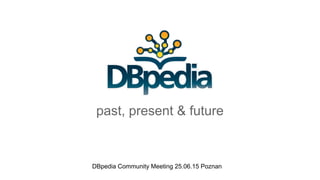DBpedia past, present & future
- 1. past, present & future DBpedia Community Meeting 25.06.15 Poznan
- 3. Get me all soccer players, who played as goalkeeper for a club that has a stadium with more than 40.000 seats and who are born in a country with more than 10 million inhabitants
- 6. How it all started - 2006 - Sören Auer (busy with his PhD) asking people: âWikipedia fact tables look like triples, donât you want to write some extractor?â - 6 months later: Sören wrote the extractor himself and asked Jens Lehmann to help with writing a paper - Chris Bizer : âWe are extracting people and place information from Wikipedia too â lets join efforts and call it DBpedia.â - Kingsley Idehen: âI need a showcase for my Virtuoso triple store.â
- 8. Taking a closer look at heterogeneity⦠- DBpedia Mappings wiki
- 9. Milestones - 2008: DBpedia Live - 2009: Scala-Based framework - 2009: Mappings wiki - 2011: Internationalization - 2011: DBpedia Spotlight - 2014: DBpedia Association (S. Hellmann)
- 10. Now DBpedia 2014 (English): 4.58 mio. entities and 583 mio. triples 131,2 mio. fact assertions (derived from infoboxes) 168,5 mio. triples representing Wikipedia structure 57,1 mio. links to external datasets Localized DBpedia version for 125 languages, built from corresponding Wikipedia versions 12 DBpedia language chapters
- 11. Now X
- 13. DBpedia has to evolve - Fusion - Validation - NLP - Enterprize
- 14. Fusion
- 15. Validation
- 16. NLP - Exploit the text⦠- Let different NLP tools & approaches compete for the best quality (in a certain language) - Need to define the interface (help needed)
- 17. Every Enterprise needs its DBpedia - Represent common sense knowledge (DBpedia and other LOD datasets) as well as the specific enterprise knowledge - Crystallization points for Linked Data intranets â an addition to SOA facilitating enterprise-wide data linking & integration - Slicing & Dicing
- 18. Other ideas? add them in http://dbpedia.org/ideas (404)
- 20. The soccer players (for the curious)
- 21. Thank you Big thanks to Sören Auer & Markus Ackermann for slide contributions
- 22. Big thanks to Sören Auer & Markus Ackermann for slide contributions






















